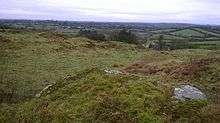Lemgare Mass Rock
Lemgare Mass Rock in The Parish of Clontibret, County Monaghan is situated adjacent to the neighboring townlands of Lisdrumgormley and Crossbane which is in Co. Armagh (Archdiocese of Armagh). A Mass rock (Carraig an Aifrinn in Irish) was a rock used as an altar in mid-17th century Ireland as a location for Roman Catholic Mass.


From a Statute (No. 15) of the Synod of Clones, held by Blessed Oliver Plunkett in 23 August 1670, we can see how a local Mass-site could have been selected in those times. It was decreed at the time that a place be appointed that was convenient to the parish priest and the parishioners. Church law at the time explains why some penal-day Mass sites were to be found centrally situated in a parish, others on the borders of two or more parishes to convenience the worshipers.
1731 Report
The "Report on the State of Popery of 1731"[1][2] identifies "Atlars ut supra" in the Parish of Clontibret.
"Ut supra" is Latin for "as stated above" and the entry reads ‘one Altar made of earth & stones uncovered’.
The entry also relates to multiple altars, these possibly being those located at Lemgare and Tassan (Catholic Historical Society of Ireland (1913) ‘Report on the State of Popery in Ireland, 1731, Archivium Hibernicum, 1, pp. 10-27).
This means that knowledge of the Mass Rocks in the townlands of both Lemgare and Tassan potentially dates back to at least 1731.
1957 survey
Lemgare Mass Rock was along with that of Tassan Mass Rock, Doohamlet and Lisglasson Mass Gardens and Dunfelimy Mass Hut were recorded in a survey carried out by Rev P O'Gallachair in 1957 on behalf of the Diocese of Clogher, and this survey was aided by Very Rev Larry Marron Adm. of Clontibret Parish at the time.
Rev. O'Gallachair mentions the "Mass Rock" in Dunfelimy being "on the site of old church of Annyalla". In making this reference he is picking up a point by over thirty years earlier by Fr James E McKenna in his ‘Parishes of Clogher’, Vol. I (Enniskillen, 1920, p. 527). The opinion is that there may be a mix up between a Mass Rock in Dunfelimy and perhaps a structure (usually a hut) which predated the old chapel at Annyalla which was built in the late 1790s.
At the time of the survey Lemgare Rock was reported as being on the lands of John Brennan, now deceased. The Brennan homestead (closest to the rock) can be clearly seen in the photo shown looking north west.
Department of Arts, Heritage and the Gaeltacht / National Monuments Service
The National Monuments Service is a section of the Department of Arts, Heritage and the Gaeltacht. They advise on legislative and policy issues relating to the archaeological heritage and have responsibility for the maintenance of a national baseline database of known archaeological sites and monuments, known as the Sites and Monuments Record which is available on the Monument Map Viewer on their website.
Lemgare Mass Rock has now been recognised by the National Monuments Service and is included in their Sites and Monuments Record (MO015-008----)
The report was compiled by Michael Moore (National Monuments Service) and uploaded onto their viewer on 25 January 2016
Strategic location
Lemgare Mass Rock would have been a good location for the people from the surrounding parishes to attend mass. In those times there were no physical borders in Ireland and people went to and from county to county and parish to parish with relative ease. Indeed, up to the 1930s a lot of young people from Derrynoose Parish would have indeed come to school in Lemgare. The location of Lemgare Mass Rock would have been strategically important due to its;
- Elevation (as from the "Carnan" which is a look out point from where you can see 4 Counties situated directly above the Rock) it would have near on impossible for any approaching Army to surprise the parishioners whilst they prayed
- Proximity to the adjoining Parish of Derrynoose- Derrynoose parish suffered greatly at the hands of the soldiers of Oliver Cromwell with the destruction of churches and property. It is widely accepted that Cromwell's men fired a cannon at the old Church in Derrynoose. However it is not clear if Cromwell was actually there as it is claimed that he did not go north at all. The cannon seems to have been fired from Macklin's hill which would be well over half a mile away.
References
- Clogher's Altars of the Penal Days. A Survey Author(s): P. Ó Gallachair Source: Clogher Record,Vol. 2, No. 1 (1957), pp. 97–130 Published by: Stable URL: https://www.jstor.org/stable/27695446[1]
- "ArcGIS Web Application". webgis.archaeology.ie. Retrieved 25 January 2016. Historic Environment Viewer- National Monuments Service Sites and Monuments Record (SMR) and the National Inventory of Architectural Heritage Report / Lemgare
- "Find A Mass Rock". Find A Mass Rock. Retrieved 25 January 2016. Find a Mass Rock
- "Geograph:: Lemgare Mass Rock (C) Maurice McAdam". www.geograph.ie. Retrieved 25 January 2016. Geograph.ie - Lemgare Mass Rock
- Gallachair, P. Ó (1 January 1957). "Clogher's Altars of the Penal Days. A Survey". Clogher Record. 2 (1): 97–130. doi:10.2307/27695446. JSTOR 27695446.